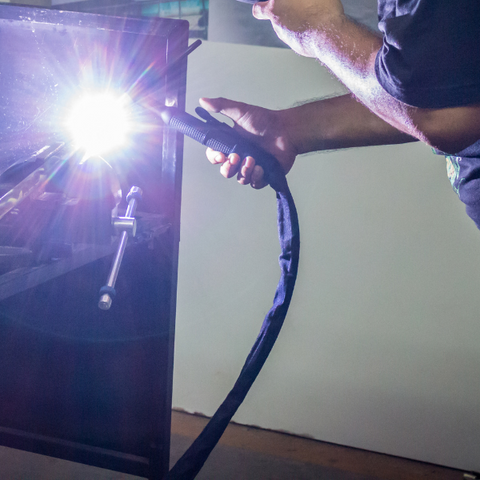Sometimes you’ve got a simple MIG welder in your shop and you need to ask a lot of it for a large to medium project. If you can’t pick up a machine with more amperage, your best bet is to carefully use your lower power MIG welder to get the job done by using a few tricks and tips. Most of the lower power, shorter duty cycle machines max out on around 3/8 to 1/2 inch metal, so keep that in mind as you consider these welding tips for your next MIG welding project.

Choose the Right Projects for Your Welder
You can always rent or borrow a welder if the project is too big for your welder. In addition, if you're welding thick metal for something on a car, such as a trailer hitch, don’t use a lower power machine. Choose your projects carefully, and remember that you need the weld to hold up under extreme stress sometimes. Run a practice weld to see if you can break the weld apart.
The longer and deeper your weld, the tougher it will be to weld with a lower power machine.
Don’t Overload Your Welder
If you have thick metal to weld or a long joint to weld, remember that you’ll be limited. Most of these lighter duty machines have less power and a short duty cycle that will kick in after a minute or two if you’re running at full power.
If you are cranking it up all of the way, take frequent breaks so that the machine doesn’t overheat. Plan ahead with your welds so that you have regular stopping points. It may help to practice starting and stopping along the weld joint if you have a long weld to make.
Use a Ground Wire for Your Welder
If you need to crank up the heat on your machine, the last thing you want to worry about will be sparks, slag, and an arc that jumps all over the place. You want the machine to run as smoothly as possible, even if you are taking it to the upper end of its power settings.
The best ground wire will maximize your contact points with the metal by having enough copper on the parts that clip to your metal. Don’t go cheap on a ground clamp! It will make a huge difference.
Use Flux Core Wire
You won’t get the most penetration in some weld joints when you use gas shielded wire. Although plain metal wire with shielding gas is a clean and effective way to make a great weld, you can push the limits of your machine by using a flux core wire for thicker metal projects.
If you use flux core wire to push your limits with the amperage of your machine, check out the machine’s settings and accessories to make sure you’re optimizing it. For instance, you may get better results by adjusting your electrode’s DC settings or by using a particular tip designed for that kind of wire.
Weld from a Different Position
Vertical uphill can sometimes help give you more strength in the final weld if you’re working on a corner joint. However, horizontal is usually an ideal position for a weld, especially for a lap joint. You don’t want to crown up the weld or leave it with too little filler, so test a few different positions to make sure you’re getting the most out of your welder.
Welders argue over whether pushing or pulling a weld works better. Usually you want to push your weld, but both tend to provide similar results. This usually boils down to your comfort level and experience.
Look for a Welder in Your Price Range
You don’t have to choose a low power welder if you’re concerned about price. In fact, you can find some great sales and free shipping for many top of the line welders. While a lower power welder can get most household jobs done, take your time picking out a welder to make sure you’ve found the best deals around.
Budget MIG machines
If you are in the market for a middle of the road MIG welder, that'll handle every small to medium size job you throw at it take a look below.

